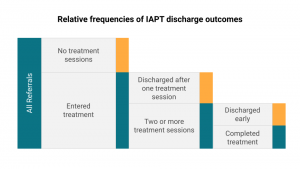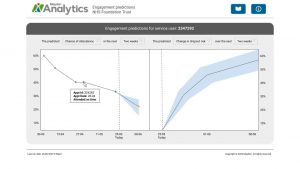
Patient drop out is a significant issue faced by Improving Access to Psychological Therapies (IAPT) services and healthcare as a whole, with at least £69M wasted on missed IAPT appointments each year.
Between January and December 2021, approximately one third of IAPT referrals ended before treatment. Of those that were treated, around one third dropped out. As shown in the following figure, the contrast between the share of individuals entering IAPT treatment and those finishing a course of treatment is stark.

Patient engagement with mental health treatment
Mayden has undertaken a series of collaborative research projects to uncover patterns in how patients engage with their therapy and to identify those at risk of dropout so that early action can be taken to improve patient outcomes. In 2020, Mayden published research conducted in collaboration with the University of Bath, which demonstrated that referral source, age and number of previous referrals were significantly associated with attendance at first appointments. Mayden’s SAPIO project found that patient sexuality is a further predictor of early dropout. However, these projects only used information collected before a patient enters treatment, providing single snapshot predictions which did not update over the course of a referral.
A new approach:
Building on existing collaborations with the University of Bath with funding from a Royal Society Short Industry Fellowship, Mayden’s research team is investigating a state-of-the art class of data analytics tools that incorporate the wealth of information gained as patients progress through their therapy. The key advantage of this dynamic approach is that we can continuously update and personalise predictions of patient engagement and other outcomes as we learn more about the individual over time.
Our project considers completing treatment and dropping out of treatment as two distinct but related outcomes. Predictions of successful completion and discharge from treatment can inform estimates of waiting times for patients yet to enter treatment. On the other hand, predictions of dropout may be used to trigger a targeted intervention to keep an at-risk patient engaged.
Next steps:
In the first stage of this project, we extensively reviewed existing approaches to dynamic prediction and carried out computational experiments to select a fast but accurate approach. In the second stage, we are putting our new expertise into practice to develop a dashboard in iaptus that will provide on-demand predictions of treatment completion and risk of dropout.
This dashboard will enable IAPT service providers to:
- Visualise data for an individual patient over the course of their referral and suggest possible future scenarios.
- Highlight patients at risk of disengaging with their therapy.
- Assess any service-level factors impacting engagement with treatment.
A mock up of the dashboard is shown below:
- The left panel shows the attendance history for a patient and a prediction for attending the next appointment.
- The right panel shows how the chance of a patient dropping out changes over the next two weeks.

These insights will help assess the likelihood and impact of dropout, ultimately reducing the cost of poor engagement in IAPT and improving outcomes for patients.
We’d love to work with you:
We’d love to hear from NHS and private providers of adult and CYP mental health services that are interested in working with us on this research, helping us to shape new dashboards and reporting features, or just to hear more about our plans for the analysis. If you would like to find out more, please contact us at projects@mayden.co.uk.
